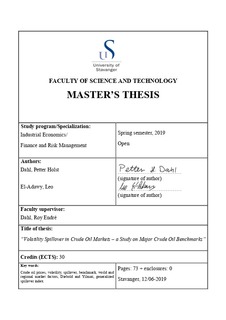| dc.contributor.advisor | Dahl, Roy Endré | |
| dc.contributor.author | Dahl, Petter Holst | |
| dc.contributor.author | El-Adawy, Leo | |
| dc.date.accessioned | 2019-11-11T12:21:03Z | |
| dc.date.available | 2019-11-11T12:21:03Z | |
| dc.date.issued | 2019-06-12 | |
| dc.identifier.uri | http://hdl.handle.net/11250/2627714 | |
| dc.description | Master's thesis in Industrial economics | nb_NO |
| dc.description.abstract | There exists a considerable body of research literature investigating the connectedness between crude oil markets and other financial markets. However, connectedness within the crude oil market has received little attention. With this in mind, the current thesis aims to highlight the research gap in literature regarding volatility spillover effects within the crude oil market. For this purpose, using daily spot prices from May 1996 to January 2019 for a set of 17 crude oils, we utilize the generalized spillover index developed in Diebold and Yilmaz (2009; 2012) to explore the connectedness within the crude oil market in terms of volatility spillovers. The generalized spillover index allows identifying the strength, as well as direction of the volatility spillovers across time. In general, our results suggest that the volatility spillover is time-varying, both in terms of strength and direction. The results further indicate that the Dubai benchmark is the most significant contributor to uncertainty in the global crude oil market, and this is especially the case after the initiation of the Arab Spring. In addition, our results suggest that the Brent benchmark behaves as a volatility buffer, reducing the uncertainty in the geographically closest regional crudes. The Dubai benchmark appears to be most affected by Middle Eastern crudes. However, our results suggest that after the Tokyo Commodity Exchange changed to Dubai as their sole underlying asset in their Crude futures contracts, the connectedness between Dubai and Asian/Australian crudes increased. As opposed to Brent, the WTI benchmark is less affected by its geographically closest crudes. These findings add important information to hedgers and speculators concerning the interdependence within the crude oil market. Further, we identify strength and direction of volatility spillover by utilizing the generalized spillover index developed in Diebold and Yilmaz (2009; 2012), and our findings are supported by market events which confirm that the methodology is well suited for this kind of analysis. | nb_NO |
| dc.language.iso | eng | nb_NO |
| dc.publisher | University of Stavanger, Norway | nb_NO |
| dc.relation.ispartofseries | Masteroppgave/UIS-TN-ISØP/2019; | |
| dc.rights | Navngivelse 4.0 Internasjonal | * |
| dc.rights.uri | http://creativecommons.org/licenses/by/4.0/deed.no | * |
| dc.subject | industriell økonomi | nb_NO |
| dc.subject | crude oil prices | nb_NO |
| dc.subject | volatility | nb_NO |
| dc.subject | spillover | nb_NO |
| dc.subject | benchmark | nb_NO |
| dc.subject | world and regional market factors | nb_NO |
| dc.subject | Diebold and Yilmaz | nb_NO |
| dc.subject | generalized spillover index | nb_NO |
| dc.subject | råoljepris | nb_NO |
| dc.title | Volatility Spillover in Crude Oil Markets - a Study on Major Crude Oil Benchmarks | nb_NO |
| dc.type | Master thesis | nb_NO |
| dc.subject.nsi | VDP::Social science: 200::Economics: 210 | nb_NO |

